In this segment of this 3-part series on building a streaming production kit you can take on the road, we’ll look at a key component of any streaming production: cameras. As you might expect, there’s a tremendous number of cameras on the market, many of them released in the last year or even the last few months.
When assembling a streaming kit that’s easy to transport from event to event, naturally you want to look for light and portable options, and the temptation is there to consider consumer models. You can use consumer cameras specifically for streaming, but I don’t recommend them for professional events (that is, anything you produce for a client or professional organization).
That said, the quality of all cameras–consumer models included–has improved immensely over the years. There’s no doubt that even today’s consumer cameras produce a fantastic signal. But for several reasons we’ll discuss in this article, professional cameras will allow you to deliver a much higher-quality streaming product for the events you capture.
HD-SDI
My first recommendation, when choosing cameras for streaming applications, is to use equipment that has an HD-SDI output. Also, in Part 3, when I discuss switchers, I’ll recommend using switchers that have HD-SDI input as well. You can certainly stream with HDMI equipment, and I’ll discuss options for that as well. But particularly when long cable runs are involved, HD-SDI will provide much more reliable and robust performance, which is why it’s the professional’s choice.
GoPro Hero 4
In addition to more standard-configuration consumer cameras, many producers may be considering the pros and cons of using the GoPro Hero4 (Figure 1, below).
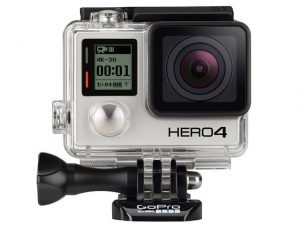
Figure 1. GoPro Hero4
My company, Mobeon, has used the Hero4 in various situations. The GoPro cameras have enabled us to get different types of camera angles when needed, and we’ve streamed from them as well. We did an interactive fashion show where we had eight GoPros streaming simultaneously from a single room. For this event, a fashion company locked a celebrity in a room, and they wanted to have an online audience see what he was doing and interact with him. They were able to contact him via social media and ask him questions and command them to do things while they were watching.
The GoPro Heros were very solid for that application, and the footage was great. But note that if you want to use Hero4s for a live switch, you’ll need to convert the HDMI signal out of the GoPro unit to SDI to send it to a switcher. The Hero4 does have HDMI outputs on it, but just make sure that you have the right cabling and the converter boxes if you want to use it for a professional application.
Remote-Controlled and Operatorless Cameras
Another challenge with doing events is that you don’t always have the resources and/or crew to capture all the angles you need with an operator on every camera. Budget is always an issue, and time can be a factor as well if a job comes in late and you don’t have time to get a crew organized to cover it. In this section I’ll discuss some solutions that can help you in producing live events when you don’t have the crew you need.
1 Beyond StreamCam AutoTracker
One option is the just-released 1 Beyond StreamCam AutoTracker (Figure 2, below). What’s great about this camera, which lists for $4995, is that it allows you have two simultaneous camera outputs on a single camera–one that is a wide shot and a another one that serves as a closeup that offers facial recognition and tracking. With the StreamCam AutoTracker, you can actually record a corporate presentation with a single camera without a camera operator. You just need to switch between the wide and tight shots as you stream the presentation.
![]()
Figure 2. 1 Beyond StreamCam AutoTracker
Not only does this camera provide the cost savings of not hiring a camera operator, but it’s also compact enough, as you can see in Figure 2, that you can pack it into a small bag.
The StreamCam AutoTracker has two HD-SDI connectors. I has a wide angle lens at the bottom, and a closeup lens at the top. And it has a 20X zoom, which is critical for a closeup shot if you’re doing conferences.
Panasonic AW-HE120s
Another fantastic option is Panasonic AW-HE120’s PTZ camera (Figure 3, below). Like the StreamCam, it features a 20X optical zoom lens, and it also has three 1/3” sensors.
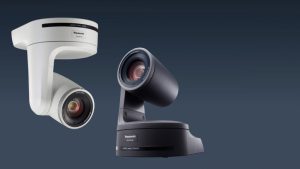
Figure 3. The Panasonic AW-HE120 PTZ camera
The HE120s are often used for live production in houses of worship. I’ve found it effective at various events because it allows full control with a control unit. In addition, it outputs through HD-SDI, and I can run it to my mixer/switcher. It has the same lens as some of Panasonic’s pro cameras, and like the StreamCam, it allows us to do a lot of productions with minimal manpower.
Other Camera Options for Budget Productions
When we do have the budgets for camera operators, but are still trying to travel with a portable kit, one of my favorite cameras to use is the Canon XA25 (Figure 4, below). The XA25 captures high-quality images; it has professional XLR audio inputs as well as HD-SDI outputs; it records to SD cards; and it has a 20X optical zoom. The quality of the images is fantastic as well. In 2014, Mobeon captured most of Streaming Media West with XA25s.
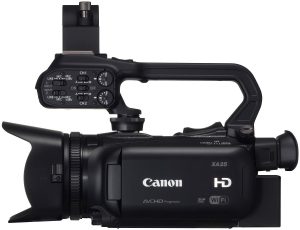
Figure 4. Canon XA25
A step up from that is the Canon XF205 (Figure 5, below). I’ve used this camera as well as its predecessor, the XF105. The XF205 is very similar to the XA25, but it’s a little larger and has a better sensor. Also, another thing is that it records to other formats, to both compact flash and SD. It also features XLR connectors and SDI outputs. If you’re looking for something that’s a little bit more on the pro side or prosumer side, the Canon XF205 is a great choice as well.
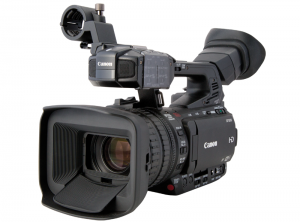
Figure 5. Canon XF205
Another camera I’d recommend for you kit if you’re traveling to shoot and stream events is the Sony PMW-200 (Figure 6, below). We’ve used this workhorse for a lot of events. We still, in fact, use the Sony EX1Rs or EX1s, which is the predecessor to this camera. Overall, the PMW-200 combines three 1/2” sensors with built-in pro functionality, including XLR inputs and HD-SDI outputs.
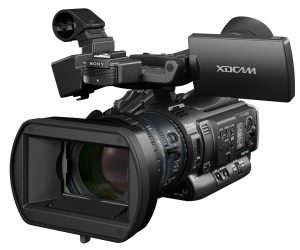
Figure 6. Sony PMW-200
If you do larger events such as stage events, I would recommend the PMW-200 as a camera. You could fit three of them in a typical Pelican case. We’ve done it. Again, the PMW-200 is a workhorse, and we’ve never had any issues with the cameras whatsoever.
4K and the Panasonic DMC-GH4
Even if you haven’t had requests for 4K delivery yet, make no mistake: 4K is here to stay. It’s a definite step up from HD, and it’s not going to turn out to be mostly hype like 3D. To future-proof yourself, I highly recommend the Panasonic DMC-GH4 (Figure 7, below).
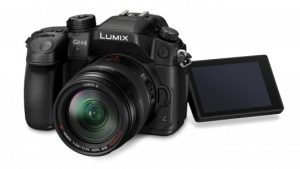
Figure 7. The Panasonic DMC-GH4
The GH4 comes in a DLSR-type configuration, and thus offers only HDMI out. But for streaming applications, you can take the HDMI out and convert that to an SDI signal, or you can take the HDMI straight out and have it patched into your switcher.
I highly recommend buying this camera in conjunction with a YAGH interface (Figure 8, below). That YAGH interface is a docking station that expands the capabilities of the camera. In addition to being able to shoot 4K, the docking station allows you to add professional XLR inputs and SDI output for your streams and also for 4K capture.
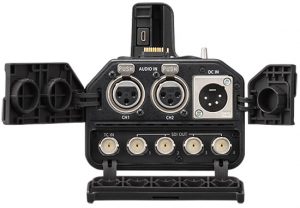
Figure 8. Panasonic DMC-GH4 with YAGH interface
The unit does capture 4K within the camera with cards, but also you can send out 4K and interface it with various 4K switchers. This is something worth considering to future proof yourself and your kit. We’ve done events with the GH4 and our clients thought from the results that we had used much more expensive cameras.
One of the most important factors to consider when you’re making your next camera purchase is whether or not the time has come to prepare for 4K.
